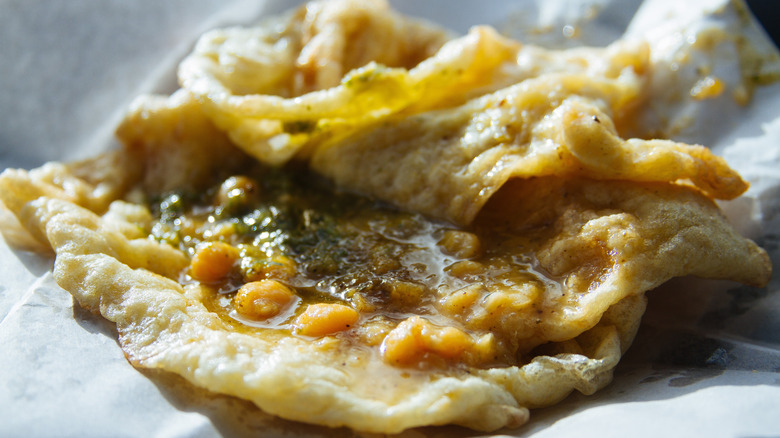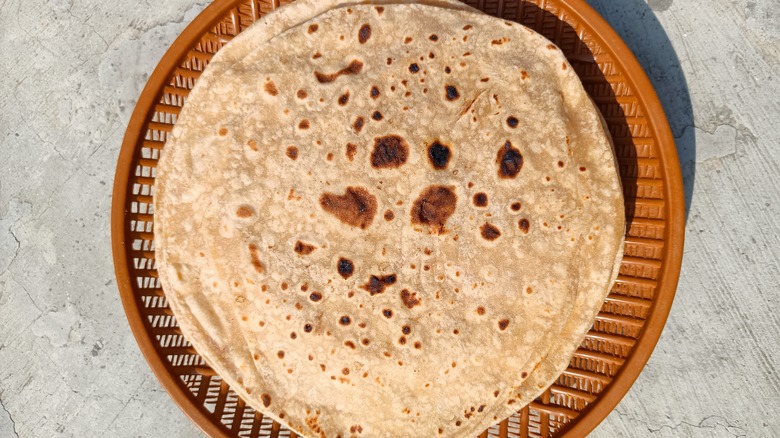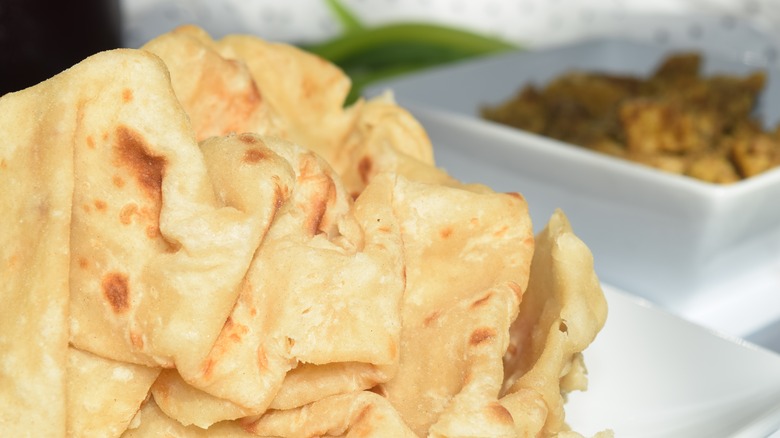What Are Trinidad Doubles And What Makes Them Different From Roti?
Trinidad doubles are a complete dish, while rotis are a component, both sharing clear South Asian roots. Whole wheat, unleavened rotis are a simple flatbread that can accompany a variety of curries, lentils, or main dishes. Trinidad doubles feature yeasted flatbreads known as baras, typically made from wheat flour, though originally, the bread was made from ground black lentils called urad dal. This exceedingly popular street food dish derives its name from using two baras to create a sort of messy sandwich for the curry.
When purchased from a street vendor — as is typical — two puffy, pliable, slightly chewy, turmeric-scented, fried baras are topped with a generous spoonful of a spicy chickpea curry known as channa, and wrapped in wax paper. In various Indian languages, chana broadly refers to many types of chickpeas, also known as garbanzo beans. The mixture is seasoned with ingredients such as garlic, onions, cumin, fresh hot peppers, and Trinidadian curry powder, which may include an extensive blend of spices such as turmeric, black pepper, curry leaves, cardamom, fenugreek, mustard seeds, coriander, cloves, and black peppercorns.
Trinidad doubles would not be complete without an assortment of sauces to finish it off — fiery Scotch bonnet pepper sauce, pickled and spiced green mango pickles called kuchela, and tangy tamarind sauce. Trinidad doubles are commonly enjoyed as a breakfast on-the-go, a quick snack, or a late-night bite.
The history of Trinidad doubles
In the mid-1800s, Trinidad and Tobago welcomed many migrants who left India to work there following the abolition of slavery. However, they were met with harsh conditions, measly wages, and indentured servitude under British colonizers. The flavors and techniques clearly indicate that South Asians originally created Trinidad doubles. In fact, the dish is very similar to a common Indian street food called chole bhature or chana bhatura — chickpeas cooked with an ample amount of spices, served with rounds of puffy fried dough.
In search of a way out of poverty, Mamool Deen and Rasulan Ali — who were of Indian Muslim descent — began selling homemade channa on the roadside. As their delicious spiced curry gained popularity, they also started making fried baras to wrap the chickpeas. Similar to the competing origins of butter chicken, other family members contest this story, claiming that it was Deen's brothers-in-law who were the true inventors of doubles. Either way, the dish has become so ubiquitous in Trinidad and Tobago's cuisine that you can find a stand selling doubles on nearly every corner.
Rotis and their Trinidadian variations
Rotis have an ancient history in the Indian subcontinent, dating back to the early civilizations in the Indus Valley, though some attribute their origin to East Africa. Undoubtedly, there are as many versions as there are regions with South Asian populations, with iterations found in Thailand, Malaysia, Guyana, Jamaica, Nepal, South Africa, Pakistan, and beyond.
At its most basic, a dough made from unsalted wheat flour and water is rolled into thin rounds and cooked in a clay oven, on a dry skillet, or over an open flame. These are ideal for eating with your hands in India, and the result is similar in texture to a flour tortilla. Rotis are also sometimes referred to as chapatis, though often chapatis are brushed with butter or ghee after cooking. Another variation is the paratha, which involves spreading ghee on the raw dough, folding, and re-rolling to create flaky layers.
In Trinidad and Tobago, rotis have buttery layers, and are made similarly to Indian parathas. Sometimes, they include baking powder, milk, or oil in the dough to make them softer. It is also common to use Trinidadian rotis to make buss up shut, where the cooked roti is beaten with wooden spoons to tease out all the layers. The name comes from how the torn roti resembles a "busted up shirt." Pieces of buss up shut are used as handheld scoops to eat dishes like saltfish buljol, coconut chicken curry, potato and chickpea curry, and curry goat.



